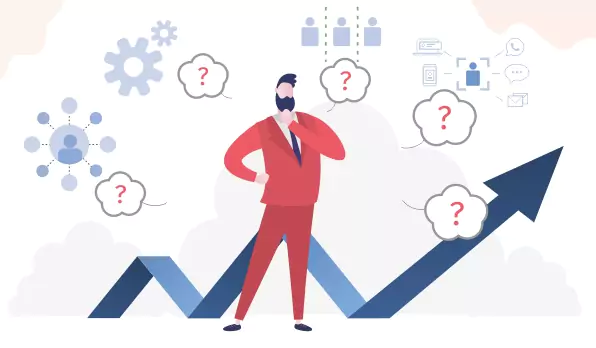Browser Push Notifications (or web push notifications) occupy a unique position in your digital marketing machinery. It is one of the most powerful channels to enable offsite user engagement, drive website traffic, and retarget anonymous website visitors.
With the world moving towards mobile and apps, it might feel that browser push notifications might take a backseat in the future. But, it is far from true.
Desktop usage still accounts for 42% of total time spent on the internet, and browser push notifications deliver the power of real-time push communication.
While mobile push notifications are limited to mobile devices and tablets, browser push notifications cover desktops as well. That’s a major advantage that browser push notifications as a standalone channel have over their app counterpart.
Combined with the power of AI, you can make your multi-channel marketing campaigns extremely powerful and agile.
Top 10 Browser Push Notification Tips
Here are the top 10 tips to maximize the impact of your browser push notifications:
Tip #1: Get your opt-in requests right
Until your users explicitly allow you to send these notifications, you can’t! So, it is crucial to secure their opt-ins. You need to be transparent while communicating what your users should expect from the push notifications you’ll be sending.
If you state the value that your notifications are going to deliver, you are likely to receive a much higher opt-in rate. That’s half the battle won!
Also, seek permission at the right time. The best way to get a high opt-in rate is to send your requests shortly after the user comes to your website.
Tip #2: Intelligently segment your audience
Browser push notification is not a broadcast channel that you can use for sending generic mass content to all your users.
You need to embrace the power of actionable analytics to segment your users based on their attributes, web behavior, and preferences to ensure that you target them with content that absolutely interests them. If you get your user segmentation right, it sets the foundation for delivering more personalized campaigns primed for higher engagement.
Tip #3: Personalise your notification content
Personalization is the heart and soul of any successful marketing campaign, and the same holds true for browser push notifications.
Leverage the power of data, including personal details, past behavioral details, and preferences, to craft highly relevant content that connects you with the users.
The secret to personalizing your content stems from a comprehensive understanding of your users. This is why gaining a unified view of your customers becomes critical.
Tip #4: Keep your content short and crisp
All your notifications should be concise and to the point.
The ideal length of your browser push notification title across industries is 20-30 characters, while that for the content is around 70 characters. That’s about 10-12 words to make the most impact! Remember to make every word count!
Optimize your content with specific, action-oriented words as you continue to gather insights into your users’ behavior based on their interactions with and responses to your browser push notifications.
Tip #5: Use rich media elements
Rich media in your browser push notifications is eye-catching. A small image in the title (which could be your brand’s logo) helps in building brand recall and recognition.
A large contextual image that supports the content makes the notification attractive and easily clickable.
You can grab the attention of your users with other interactive elements, such as emojis. Use them tastefully to suit the tone and context of your campaign content.
Tip #6: Use a clear Call-To-Action (CTA)
The purpose of the browser push notification is to bring users back to your website. A compelling CTA can do just that.
Use deep linking to directly take the message to the relevant landing page or product page on the website instead of the home page. Guide them on what to do next without complicating the entire navigation path.
Related Post: 8 Tips to Increase User Engagement by Deep Linking Push Notifications
Tip #7: Get your time of delivery just right
The time of the day and day of the week greatly affect the performance of your browser push notification campaign.
For instance, a weekend offer would work well if sent on a Friday evening, not on a Monday morning. A breaking news update has to be sent in real time and not when the news becomes stale.
It is also crucial to take your users’ behavioral preferences into account. By optimizing your send times, you can ensure that each user receives your notification at his/her most preferred time.
In addition, you need to ensure that your campaigns run for the defined duration, taking into consideration how time-sensitive they are.
Scheduling your campaigns as per the users’ time zone is also very beneficial in ensuring that your notifications reach the users at the right time.
Tip #8: Preview carefully before hitting send!
Different web browsers render push notifications differently. Notifications on Chrome appear differently based on whether the users are on Mac or on Windows.
Also, a considerable percentage of users browse websites on their smartphones. You must ensure that your notifications are optimized for a satisfactory mobile viewing experience.
Make attention to detail a part of your campaign best practices. You need to preview your browser push notifications to ensure:
- There are no mistakes in the copy
- The title of the notification doesn’t appear cut off and is entirely visible
- All rich media elements render correctly across browsers
We also recommend that you run a test campaign before sending it out to your users.
Tip #9: Measure effectiveness, constantly
To ensure that the campaign you are going to send will create the intended impact, you can use features like split A/B tests and control groups at your disposal.
Test multiple variations of your campaign with smaller groups. Based on the performance analysis, re-calibrate the campaign content, send times, etc.
Related post: Measure your Marketing Campaign’s Effectiveness and ROI with Control Groups
Tip #10: Optimise your frequency of delivery
While browser push notifications are highly engaging, it is also important to realize that if sent too frequently, they become annoying and can lead to an instant opt-out or unsubscribe.
There is no defined optimum frequency, though.
For instance, while it is okay for a news website to send 3-5 notifications throughout the day to share news updates, it might not be very beneficial for e-commerce brands to send more than 2 browser push notifications a day. You need to strategize and plan what suits you best.
While running multiple campaigns, you need to place a cap on the frequency at which your browser push notifications are delivered. This is to ensure that your users don’t get overwhelmed and completely put off by your marketing communication.
In fact, the CTRs of browser push notifications are directly linked to the frequency with which users receive the same. CTRs steadily decline every time an extra push notification is sent in a single day by a particular website.
Conclusion
By following the above tips, browser push notifications can definitely help you increase 3 key metrics:
- Website Traffic
- User Acquisition
- Offsite user engagement
Since you can target unregistered or anonymous users (provided they have subscribed to receive these notifications), browser push notifications constitute the most crucial means to acquire new users for your website.
While a data-driven approach will add more meat to your browser push notification strategy, harnessing the power of AI can help you drive far more personalized, contextualized, and timely campaigns.
To learn more about how you can scale your website engagement with browser push notifications, get in touch with us today.










